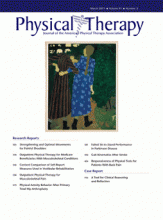Abstract
Background Physical therapists should understand the content included in self-report questionnaires in order to choose the appropriate questionnaire for examination and follow-up purposes. The International Classification of Functioning, Disability and Health (ICF) provides a universal and standard language for the description of health and health-related states and can be used for the content comparison of self-report questionnaires.
Objective The purpose of this study was to describe and compare the contents covered by 8 self-report measures used in vestibular rehabilitation based on the linkage of their content to the ICF.
Design This was a cross-sectional study.
Method Eight vestibular questionnaires were identified and linked to the ICF by 2 health care professionals according to established linking rules. Based on the linking, the contents of the 8 questionnaires were compared and the interobserver agreement between 2 raters was estimated using kappa coefficients.
Results A total of 312 meaningful concepts from the 164 items of the 8 vestibular questionnaires were identified and linked to the ICF. The meaningful concepts identified were linked to 51 different ICF components: 19 categories of the component “body functions,” 30 categories of the component “activities and participation,” and 2 categories of the component “environmental factors.” Forty-two concepts could not be linked to any of the ICF components. The estimated kappa coefficients for 2 raters at the component and first and second levels of the ICF ranged from 0.83 to 0.96.
Limitations The method of identifying vestibular measures was not based on a systematic search; instead, the most widely used instruments in the field of vestibular rehabilitation were selected. Thus, the study results are limited to the examined vestibular instruments.
Conclusion Using the ICF as a theoretical framework was found to be useful for comparing the content of health status questionnaires, as well as for exploring the focus of the measures currently in use in vestibular rehabilitation.
Footnotes
Mrs Alghwiri and Dr Whitney provided concept/idea/research design, writing, data collection, and project management. Dr Marchetti provided data collection. Dr Marchetti and Dr Whitney provided consultation (including review of manuscript before submission).
The authors thank Joan Rogers, OTR, PhD, for serving as the expert who resolved disagreement between the 2 clinician raters.
- Received August 4, 2010.
- Accepted November 22, 2010.












